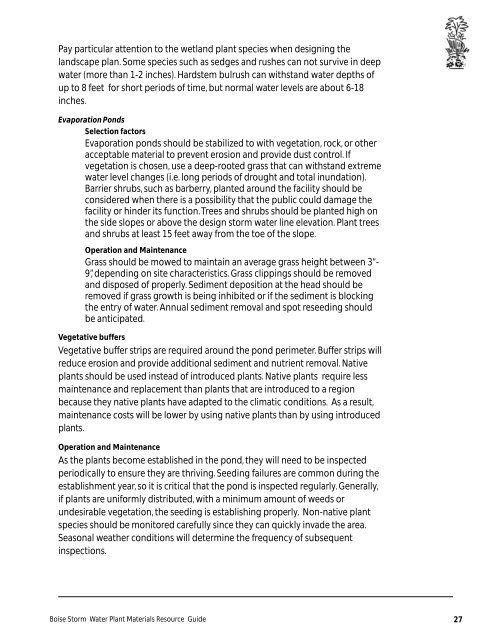Storm Water Plant Materials A Resource Guide
Storm Water Plant Materials A Resource Guide
Storm Water Plant Materials A Resource Guide
Create successful ePaper yourself
Turn your PDF publications into a flip-book with our unique Google optimized e-Paper software.
Pay particular attention to the wetland plant species when designing the<br />
landscape plan. Some species such as sedges and rushes can not survive in deep<br />
water (more than 1-2 inches). Hardstem bulrush can withstand water depths of<br />
up to 8 feet for short periods of time, but normal water levels are about 6-18<br />
inches.<br />
Evaporation Ponds<br />
Selection factors<br />
Evaporation ponds should be stabilized to with vegetation, rock, or other<br />
acceptable material to prevent erosion and provide dust control. If<br />
vegetation is chosen, use a deep-rooted grass that can withstand extreme<br />
water level changes (i.e. long periods of drought and total inundation).<br />
Barrier shrubs, such as barberry, planted around the facility should be<br />
considered when there is a possibility that the public could damage the<br />
facility or hinder its function. Trees and shrubs should be planted high on<br />
the side slopes or above the design storm water line elevation. <strong>Plant</strong> trees<br />
and shrubs at least 15 feet away from the toe of the slope.<br />
Operation and Maintenance<br />
Grass should be mowed to maintain an average grass height between 3”-<br />
9”, depending on site characteristics. Grass clippings should be removed<br />
and disposed of properly. Sediment deposition at the head should be<br />
removed if grass growth is being inhibited or if the sediment is blocking<br />
the entry of water. Annual sediment removal and spot reseeding should<br />
be anticipated.<br />
Vegetative buffers<br />
Vegetative buffer strips are required around the pond perimeter. Buffer strips will<br />
reduce erosion and provide additional sediment and nutrient removal. Native<br />
plants should be used instead of introduced plants. Native plants require less<br />
maintenance and replacement than plants that are introduced to a region<br />
because they native plants have adapted to the climatic conditions. As a result,<br />
maintenance costs will be lower by using native plants than by using introduced<br />
plants.<br />
Operation and Maintenance<br />
As the plants become established in the pond, they will need to be inspected<br />
periodically to ensure they are thriving. Seeding failures are common during the<br />
establishment year, so it is critical that the pond is inspected regularly. Generally,<br />
if plants are uniformly distributed, with a minimum amount of weeds or<br />
undesirable vegetation, the seeding is establishing properly. Non-native plant<br />
species should be monitored carefully since they can quickly invade the area.<br />
Seasonal weather conditions will determine the frequency of subsequent<br />
inspections.<br />
Boise <strong>Storm</strong> <strong>Water</strong> <strong>Plant</strong> <strong>Materials</strong> <strong>Resource</strong> <strong>Guide</strong><br />
27

















